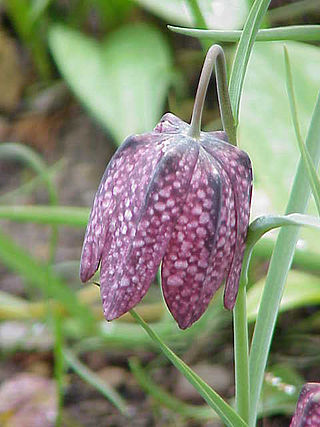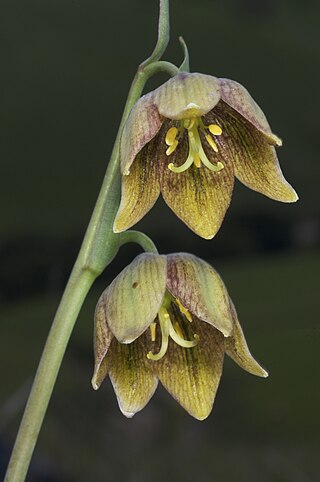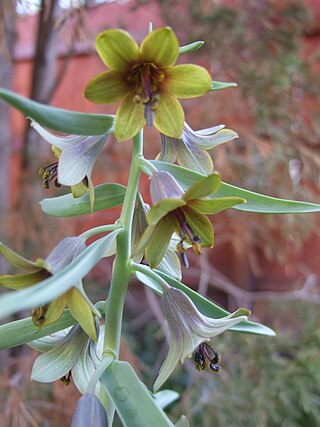
Fritillaria (fritillaries) is a genus of spring flowering herbaceous bulbous perennial plants in the lily family (Liliaceae). The type species, Fritillaria meleagris, was first described in Europe in 1571, while other species from the Middle East and Asia were also introduced to Europe at that time. The genus has about 130–140 species divided among eight subgenera. The flowers are usually solitary, nodding and bell-shaped with bulbs that have fleshy scales, resembling those of lilies. They are known for their large genome size and genetically are very closely related to lilies. They are native to the temperate regions of the Northern hemisphere, from the Mediterranean and North Africa through Eurasia and southwest Asia to western North America. Many are endangered due to enthusiastic picking.

The lily family, Liliaceae, consists of about 15 genera and 610 species of flowering plants within the order Liliales. They are monocotyledonous, perennial, herbaceous, often bulbous geophytes. Plants in this family have evolved with a fair amount of morphological diversity despite genetic similarity. Common characteristics include large flowers with parts arranged in threes: with six colored or patterned petaloid tepals arranged in two whorls, six stamens and a superior ovary. The leaves are linear in shape, with their veins usually arranged parallel to the edges, single and arranged alternating on the stem, or in a rosette at the base. Most species are grown from bulbs, although some have rhizomes. First described in 1789, the lily family became a paraphyletic "catch-all" (wastebasket) group of lilioid monocots that did not fit into other families and included a great number of genera now included in other families and in some cases in other orders. Consequently, many sources and descriptions labelled "Liliaceae" deal with the broader sense of the family.

A pulmonary artery is an artery in the pulmonary circulation that carries deoxygenated blood from the right side of the heart to the lungs. The largest pulmonary artery is the main pulmonary artery or pulmonary trunk from the heart, and the smallest ones are the arterioles, which lead to the capillaries that surround the pulmonary alveoli.

Larvaceans or appendicularians, class Appendicularia, are solitary, free-swimming tunicates found throughout the world's oceans. While larvaceans are filter feeders like most other tunicates, they keep their tadpole-like shape as adults, with the notochord running through the tail. They can be found in the pelagic zone, specifically in the photic zone, or sometimes deeper. They are transparent planktonic animals, usually ranging from 2 mm (0.079 in) to 8 mm (0.31 in) in body length including the tail, although giant larvaceans can reach up to 10 cm (3.9 in) in length.

Entandrophragma is a genus of eleven known species of deciduous trees in the family Meliaceae.

The thyroid ima artery is an artery of the head and neck. It is an anatomical variant that, when present, supplies blood to the thyroid gland primarily, or the trachea, the parathyroid gland and the thymus gland in rare cases. It has also been reported to be a compensatory artery when one or both of the inferior thyroid arteries are absent, and in a few cases the only source of blood to the thyroid gland. Furthermore, it varies in origin, size, blood supply, and termination, and occurs in around 3.8% of the population and is 4.5 times more common in fetuses than in adults. Because of the variations and rarity, it may lead to surgical complications, particularly during tracheostomy and other airway managements.

The Polyceridae are a taxonomic family of sea slugs, dorid nudibranchs, marine gastropod mollusks within the superfamily Polyceroidea.

Fritillaria agrestis is a species of fritillary known by the common name stinkbells. It is endemic to California, where it is found in scattered populations from Mendocino County and Butte County to Ventura County. It grows in heavy soils, particularly clay. It is not common.

Polydesmida is the largest order of millipedes, with more than 5,000 species, including all the millipedes reported to produce hydrogen cyanide (HCN). This order is also the most diverse of the millipede orders in terms of morphology. Millipedes in this order are found in all regions of the world other than Antarctica.

Doriopsilla is a genus of sea slugs, dorid nudibranchs, shell-less marine gastropod molluscs in the family Dendrodorididae.

Notholirion is a small Asian genus of bulbous plants in the lily family, Liliaceae. It is closely related to Lilium, but each individual flowers only once, and then dies after producing offsets. The bulb is covered by a tunic. Leaves are basal, produced in autumn and winter.

The Lilioideae are a subfamily of monocotyledonous perennial, herbaceous mainly bulbous flowering plants in the lily family, Liliaceae. They are found predominantly in the temperate and colder regions of the Northern Hemisphere, particularly East Asia and North America. The subfamily includes two tribes. They are of economic importance, particularly the lilies and tulips.
Oswald Seeliger was a German zoologist, known for his studies involving the anatomy and developmental history of tunicates.
Edward Martyn Rix is a British botanist, collector, horticulturist and author. Following completion of a PhD on Fritillaria at Cambridge University, he worked in Zürich, Switzerland and at the Royal Horticultural Society gardens at Wisley. He is the author of many books and articles on plants and horticulture and is the editor of Curtis's Botanical Magazine, based at the Royal Botanic Gardens, Kew in London.

Fritillaria raddeana is a perennial herbaceous bulbous plant, distributed in Iran, Turkmenistan and Kashmir. It is a species in the genus Fritillaria, in the lily family Liliaceae. It is placed in the subgenus Petilium. Resembling Fritillaria imperialis, but shorter, it is sometimes referred to as the dwarf crown imperial.

Fritillaria sewerzowii is a perennial herbaceous bulbous plant, distributed in alpine areas of central Asia. It is a species in the genus Fritillaria, in the lily family Liliaceae. It is placed in the subgenus Korolkowia.

Fritillaria dagana is a rare bulbous herbaceous perennial plant native to Siberia, Russia. It is a species in the genus Fritillaria of the family Liliaceae. It is placed in the subgenus Liliorhiza.
Kowalevskia is a genus of larvacean tunicates, the only one in the family Kowalevskiidae.

Appendicularia is a genus of larvaceans in the family Fritillariidae.
Fritillaria is a genus of larvacean tunicates belonging to the family Fritillariidae.















